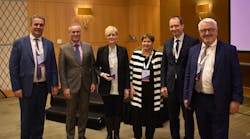Few experiences are as rewarding as watching young people discover the joys of aviation firsthand. That’s why I have been so privileged to spend part of my last two summers building airplanes with the U.S. high school student winners of the GAMA/Build A Plane Aviation Design Challenge. And based on my experience, I can say with confidence that the future of the aircraft industry looks very bright.
A willingness to learn
The students who won the Aviation Design Challenge — a science, technology, education, and math (STEM) competition — hailed from diverse backgrounds: rural Minnesota, a small city an hour outside of Detroit, and urban Las Vegas. Some had never flown in an airplane before traveling to Arlington, WA, for the build, and each had varying levels of familiarity with the tools needed to assemble a Glasair Sportsman airplane. But they all brought a desire to work hard and a willingness to learn and master the basics of aircraft assembly — from bucking rivets to sanding the airframe, fabricating and attaching fuel lines, and mounting the gear. As a result, after spending two weeks building an airplane — and then watching it take flight — nearly every student said he or she planned to pursue a career in aviation.
This kind of response is exactly the reason GAMA and Build A Plane initially teamed up to sponsor this competition in 2013, and why we are proud to be continuing the program for a third year. It also shows why it’s critical that our industry continue to develop new, innovative ways to attract more students to rewarding careers in general aviation manufacturing and maintenance.
A quick look at the broader manufacturing industry illustrates the need to build our future workforce. The Accenture 2014 Manufacturing Skills and Training Study showed that more than 75 percent of manufacturers reported a moderate to severe shortage of skilled resources. What’s more, U.S. manufacturers stand to see their earnings shrink up to 11 percent annually due to greater production costs and revenue losses stemming from a skills shortage.
Efforts to close the skills-labor gap
GAMA continues to be involved with other efforts to ensure today’s students are tomorrow’s aviation leaders. We are working with the National Aviation Consortium, a group of technical and community colleges that is collaborating with aerospace industry leaders to offer cutting-edge curriculum to close the skills-labor gap in the aerospace industry and provide more career opportunities in aviation manufacturing. And last September, GAMA helped to sponsor the launch of the Flying Classroom, an initiative led by aviator Barrington Irving to interest K-8 students in STEM through aviation.
As our industry continues to grow, so will our need for skilled, educated employees. Fortunately, our industry offers some of the most highly skilled and good-paying jobs available, allows our employees to play active roles in their communities, and manufactures products that typify the best in the human spirit. Ensuring that today’s students know about and are prepared for these opportunities is critical. As we’ve found at GAMA, it’s a very worthwhile investment — and a lot of fun, too.
Pete Bunce is president and CEO of the General Aviation Manufacturers Association (GAMA), which represents more than 85 of the world’s leading manufacturers of general aviation airplanes and rotorcraft, engines, avionics, components, and related services. GAMA’s members also operate repair stations, fixed based operations, pilot and maintenance training facilities and they manage fleets of aircraft.





